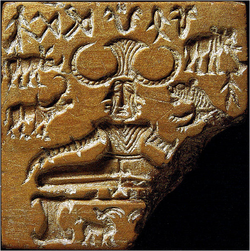| A Brief Introduction to Hinduism |
Roots of Hinduism

In the Indus Valley, there was a carving found depicting a Proto-Shiva figure in a yogi posture. This carving was found to be over 3500 years old. The traces of the Hindu faith are so deeply embedded into the history of the region that it is a part of the culture. Little is known of the earliest forms of Hinduism, as it was an oral tradition. We get most of our clues from the Vedic Period.
The Vedic Period started around 1000 BCE; it was the time when the oral traditions were first written down in the Pallava Gupta. At the time, minor Vedic Gods were worshiped locally almost as folk deities. Karma and reincarnation connect all these Vedic Gods as avatars and reincarnations of the major Gods. This cemented the Brahmin caste and unified a collection of beliefs into one religion.
With the birth of a new religion, there came the after-birth of ritual, the fire ritual being one of the oldest and most important. Adherence to ritual was paramount at this time. The Brahmin had a great deal of power in the region. The Vedas continued to grow in number, as the rituals or stories were written into the canon. The Brahmin would hold power, culminating with the advent of Brahmanistic Hinduism.
It was in the sixth century BCE that the Brahmin started to lose their controlling influence in the region. Ideas from religions such as Buddhism began to have a huge impact on the region. There was a general rejection of ritual, and mystic traditions focusing on the self grew in popularity. The idea of a supreme being gained power and Hinduism adopted the concept, calling it "Brahman." The new Hinduism worked to accept other forms of practice, and ritual became less a part of daily life, and more of a celebration.
The Middle ages were considered the end of the "Hindu golden age." The once-religion had lost the controlling influence of the priest caste. Without any overseeing force, the once-richly philosophical Vedas had been reduced to material for the innumerable sects to have scholastic quarrels over. However, in the eighth century, the sects worked together to provide a mythical backstory for Hinduism as a whole. With a few reform movements and the addition of the yogic schools, Hinduism unified and became the basis for the religion we think of it as today.
Sources:http://www.ochs.org.uk/
http://hinduism.iskcon.org/
Michaels, A (2004), Hinduism: Past and Present (5th ed.), Princeton University Press
Jones, Constance; Ryan, James D. (2007), Encyclopedia of Hinduism, New York, USA: Infobase Publishing
The Vedic Period started around 1000 BCE; it was the time when the oral traditions were first written down in the Pallava Gupta. At the time, minor Vedic Gods were worshiped locally almost as folk deities. Karma and reincarnation connect all these Vedic Gods as avatars and reincarnations of the major Gods. This cemented the Brahmin caste and unified a collection of beliefs into one religion.
With the birth of a new religion, there came the after-birth of ritual, the fire ritual being one of the oldest and most important. Adherence to ritual was paramount at this time. The Brahmin had a great deal of power in the region. The Vedas continued to grow in number, as the rituals or stories were written into the canon. The Brahmin would hold power, culminating with the advent of Brahmanistic Hinduism.
It was in the sixth century BCE that the Brahmin started to lose their controlling influence in the region. Ideas from religions such as Buddhism began to have a huge impact on the region. There was a general rejection of ritual, and mystic traditions focusing on the self grew in popularity. The idea of a supreme being gained power and Hinduism adopted the concept, calling it "Brahman." The new Hinduism worked to accept other forms of practice, and ritual became less a part of daily life, and more of a celebration.
The Middle ages were considered the end of the "Hindu golden age." The once-religion had lost the controlling influence of the priest caste. Without any overseeing force, the once-richly philosophical Vedas had been reduced to material for the innumerable sects to have scholastic quarrels over. However, in the eighth century, the sects worked together to provide a mythical backstory for Hinduism as a whole. With a few reform movements and the addition of the yogic schools, Hinduism unified and became the basis for the religion we think of it as today.
Sources:http://www.ochs.org.uk/
http://hinduism.iskcon.org/
Michaels, A (2004), Hinduism: Past and Present (5th ed.), Princeton University Press
Jones, Constance; Ryan, James D. (2007), Encyclopedia of Hinduism, New York, USA: Infobase Publishing
